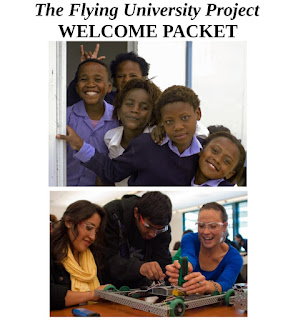Designing Communities of Learning - Our Welcome Packet
As part of our toolkit for motivating our students to math excellence, we created a Welcome Packet. That packet contains the following elements: a couple of pictures of kids who look like the kids we are trying to reach, a description of the Flying University Project, a Family Contact Form, An Authorization from Parent or Legal Guardian to Record Video and/or Images of a Child, a Syllabus, and a description of our Rewards System and Code of Conduct. Here's how we intend the most important of these elements to work.
- The pictures: These pictures present a warmly human portrayal of children of color. This is meant to counter the message pushed on our kids by the current dominant American society, a message that says that our kids are defective. By these pictures, our kids can see that they are not, and that they are in fact worthy of dignity.
- The description of the Flying University Project: This is meant for older kids and for parents or guardians. This gives some of the political reasons for our Project and presents our effort at grassroots math education as part of a larger movement of self-sufficiency and resistance to oppression. It also lets parents know that some sacrifice will be required in order to produce families with math excellence. (Gotta turn off the TV and spend a half-hour or an hour a night working on math...)
- The Parental Contact Form: This is not just for the sake of knowing who to contact in case of an emergency. Rather, the purpose is to have a means of involving the parents in the decisions that are made concerning our teaching group. As Paulo Friere says in his Pedagogy of the Oppressed, the revolutionary teacher takes his or her place alongside the students instead of over them. While this can only be done in a partial way with kids, it can be done much more deeply with their parents. And when we teachers are absent from the kids, their parents can reinforce the lessons that have been taught and help the kids with practice. We want the parents to regard themselves as full-fledged "voting members" and co-contributors in the Flying University Project.
- The Video Authorization Form: We regularly record videos and still images of our students. These recordings serve two purposes. First, they are a great motivator for kids. (We give them rewards for correctly solving math problems while they are being videoed, and we promise them that once we post their videos online, they will become almost famous! ;) ) Seriously, however, we have observed how recording videos of the incremental learning of children motivates them to excel at difficult skills that require deliberate practice. Examples of this can be seen in such domains as music, as shown in videos of child classical guitar prodigies such as Jennifer Kim and Kevin Loh. Instead of using videos to develop musical talent, we use them to motivate the development of mathematical skill. These videos give a reason to boast, not only to the students but to their families as well. But a second, and equally important purpose of the videos is to shut the mouths of those members of the dominant culture who want to portray people of color as criminals or mentally deficient. Posting videos of children of color solving increasingly difficult math problems (including problems that demand high-level critical thinking skills) prevents the dominant culture from dehumanizing us.
- The Rewards System: We recognize that becoming excellent at math requires significant amounts of deliberate practice. We also recognize that this deliberate practice does not always taste good to kids. But we recognize that tangible rewards can motivate kids to undertake the deliberate practice necessary - especially when the rewards reinforce the lesson that the skill being practiced is relevant to the kids' lives.

Comments